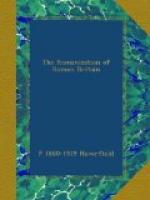It remains true, of course, that, till a language or a custom is wholly dead and gone, it can always revive under special conditions. The rustic poor of a country seldom affect the trend of its history. But they have a curious persistent force. Superstitions, sentiments, even language and the consciousness of nationality, linger dormant among them, till an upheaval comes, till buried seeds are thrown out on the surface and forgotten plants blossom once more. The world has seen many examples of such resurrection—not least in modern Europe. The Roman Empire offers us singularly few instances, but it would be untrue to say that there were none.
But while it is true generally that Romanization spread rapidly in the west, we must admit great differences between different districts even of the same provincial areas. Some grew Romanized soon and thoroughly, others slowly and imperfectly. For instance, Gallia Comata, that is, Gaul north and west of the Cevennes, contrasted sharply in this respect with Narbonensis, the province of the Mediterranean coast and the Rhone Valley. This latter, even in the first century A.D., had become Italia verius quam provincia. The other lagged behind. Neither the Latin speech nor the Latin forms of municipal government became quickly common. Yet even in northern Gaul Romanization strode forward. The Gaulish monarchy of A.D. 258-73 shows us the position north of the Cevennes just after the middle of the third century. In it Roman and native elements were mixed. Its emperors were called not only Latinius Postumus, but also Piavonius and Esuvius Tetricus. Its coins were inscribed not only ‘Romae Aeternae’, but also ‘Herculi Deusoniensi’ and ‘Herculi Magusano’. It not only claimed independence of Rome or perhaps equality with it, but it aspired to be the Empire. It had its own senate, copied from that of Rome; tribunicia potestas was conferred on its ruler and the title princeps iuventutis on its heir apparent. At that date it was still possible for a Gaulish ruler to bear a Gaulish name and to appeal to some sort of native memories. But the appeal was made without any sense that it was incompatible with a general acceptance of Roman fashions, language, and constitution. Postumus, if he had had the chance, would have made himself Emperor of Rome. Though the native element in Gaul had not died out of mind, at any rate its opposition to the Roman had become forgotten. It had become little more than a picturesque and interesting contrast to the all-absorbing Roman element. A hundred and thirty years later it had almost wholly vanished.




